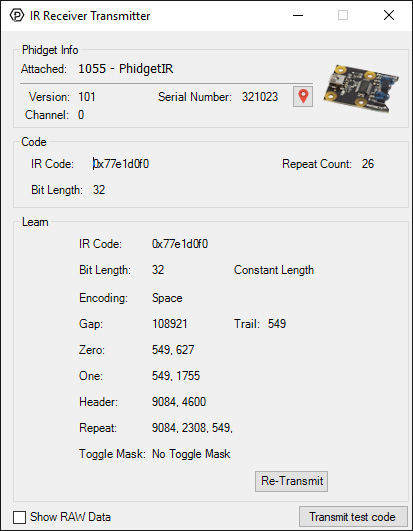Template:UgIR: Difference between revisions
From Phidgets Support
No edit summary |
No edit summary |
||
| Line 6: | Line 6: | ||
{{UGExampleDescription}} | {{UGExampleDescription}} | ||
* The ''Show RAW Data'' checkbox toggles the RAW data window. This window lets you see incoming codes as pulses and gaps (expressed as numbers in milliseconds). You can also re-transmit this raw data. | * The ''Show RAW Data'' checkbox toggles the RAW data window. This window lets you see incoming codes as pulses and gaps (expressed as numbers in milliseconds). You can also re-transmit this raw data. | ||
* '''IR Code:''' the hexadecimal code corresponding to the signal just received. | |||
* '''Repeat Count:''' how many times the same code has been received in a row. If you hold down a button on most remote controllers, it will continually transmit repeat codes. | |||
* '''Bit Length:''' the length of the code in bits. | |||
*When a code is repeated multiple times, the {{{1}}} will learn the code. It will display the relevant information in the ''Learn'' box. For more information, see the [[#Technical_Details|technical section]]. | *When a code is repeated multiple times, the {{{1}}} will learn the code. It will display the relevant information in the ''Learn'' box. For more information, see the [[#Technical_Details|technical section]]. | ||
<br clear="all"> | <br clear="all"> | ||
Revision as of 21:45, 14 June 2017
IR Receiver/Transmitter
Double-click on the IR object, labelled PhidgetIR, in order to run the example:

General information about the selected object will be displayed at the top of the window. You can also experiment with the following functionality:
- The Show RAW Data checkbox toggles the RAW data window. This window lets you see incoming codes as pulses and gaps (expressed as numbers in milliseconds). You can also re-transmit this raw data.
- IR Code: the hexadecimal code corresponding to the signal just received.
- Repeat Count: how many times the same code has been received in a row. If you hold down a button on most remote controllers, it will continually transmit repeat codes.
- Bit Length: the length of the code in bits.
- When a code is repeated multiple times, the {{{1}}} will learn the code. It will display the relevant information in the Learn box. For more information, see the technical section.
